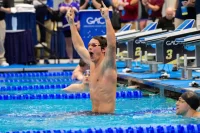
Bates unveils bold new look for the Bobcat

Bates student Tim Campbell sports his new Bobcat T-shirt at Saturday’s Bates-Tufts men’s basketball game. The new Bobcat was revealed at halftime of the game. Photo by Phyllis Graber Jensen/Bates College.
LEWISTON, Maine — Bates College made public its new Bobcat logo at halftime of today’s Bates-Tufts men’s basketball game, unfurling a garnet banner depicting a bold, new look for the college mascot.
Created by Skye Design Studios (SDS), the new Bobcat strikes a familiar note with the 17-year-old design it replaces, while making a fresh and stylish departure from the logos of other institutions and teams using the Bobcat nickname. Owned and operated by Maine native Skye Dillon, SDS is a brand identity and design firm located in the greater New York City area.
“Timeless in nature, the new Bobcat icon’s confidence is rendered in a clean, one-color graphic that serves as a metaphor to Bates’ distinguished reputation, as well as the simple lifestyle associated with Maine,” said Dillon. “The Bobcat’s head-only pose engages with the viewer, representing the intimate nature of Bates’ tight-knit community.”
Representing the entire college, the new Bobcat will eventually be visible throughout campus, yet will likely be seen most often in relation to Bates’ 31 varsity athletic teams. It will figure prominently in Bates’ forthcoming redesigned athletics website (a project in which the college is partnering with PrestoSports), and may appear on some uniforms as early as spring 2013.
The college’s athletics marketing committee, including four students and alumni, recommended an update of the Bobcat logo and oversaw its development.
“The committee worked extremely well together to create a logo that would appeal to all members of the Bates community, past and present,” said Luke Matarazzo, a Bates junior and committee member. “The new Bobcat conveys confidence, fearlessness and valor — all characteristics that we value here at Bates. The development of the new logo took lots of time, effort and cooperation, but it was well worth it.”
In September and October the committee engaged Dillon as designer, and then canvassed the Bates community — students, alumni, faculty and staff — for artistic direction.
Dillon visited campus in October, taking in a variety of athletic contests, meeting with the committee and poring through archival photographs.
“The input contributed by the campus community provided an authentic perspective on the school’s identity,” said Dillon.
“Skye is a natural collaborator,” said McHugh, “a real pleasure to work with.”
Dillon’s design precisely meets the qualities the survey suggested:
- the Bobcat head alone (not a full body or something in between);
- preference for “distinguished,” among logo styles described as “modern,” “traditional,” “distinguished,” “aggressive” and “whimsical”:
- resemblance to the 1997 logo, rather than a clear departure from it.
“With the input of both current students and alumni, the committee got a unique perspective on how the Bobcat functions for different people,” said senior Catherine Tuttle, another member of the athletics marketing committee. “The Bobcat is something we all wear proudly, and I’m thrilled with the new, more regal look.”
The Bobcat was adopted as the college mascot in 1924, during an all-campus vote in the Bates Chapel. “It is small, but oh how it can fight,” said one supporter.



